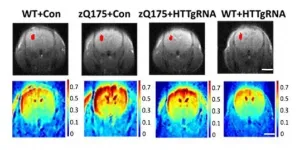(Press-News.org) LAWRENCE -- A new paper appearing in Biology Letters describes the oldest-known fragmentary bat fossils from Asia, pushing back the evolutionary record for bats on that continent to the dawn of the Eocene and boosting the possibility that the bat family's "mysterious" origins someday might be traced to Asia.
A team based at the University of Kansas and China performed the fieldwork in the Junggar Basin -- a very remote sedimentary basin in northwest China -- to discover two fossil teeth belonging to two separate specimens of the bat, dubbed Altaynycteris aurora.
The new fossil specimens help scientists better understand bat evolution and geographic distribution and better grasp how mammals developed in general.
"Bats show up in the fossil record out of the blue about 55-ish million years ago -- and they're already scattered on different parts of the globe," said lead author Matthew Jones, a doctoral student at the KU Biodiversity Institute and Department of Ecology & Evolutionary Biology. "Before this, the earliest bats are known from a couple of places in Europe -- Portugal and southern France -- and Australia. So, when they show up early in the fossil record as these fragmentary fossils they're already effectively worldwide. By the time we get their earliest known full skeletons, they look modern -- they can fly, and most of them are able to echolocate. But we don't really know anything about this transitional period from non-bats to bats. We don't even really know what their closest living relatives are among mammals. It's a really big evolutionary mystery where bats came from and how they evolved and became so specialized."
Jones' co-authors were K. Christopher Beard, senior curator at the KU Biodiversity Institute and Foundation Distinguished Professor of Ecology & Evolutionary Biology at KU; and Qiang Li and Xijun Ni of the Key Laboratory of Vertebrate Evolution and Human Origins, Institute of Vertebrate Paleontology and Paleoanthropology at the Chinese Academy of Sciences and the Center for Excellence in Life and Paleoenvironment at the Chinese Academy of Sciences.
The ancient bat teeth were discovered through painstaking fieldwork in the Junggar Basin, where the KU researchers worked at an isolated field site established by their Chinese colleagues, one of two sites in the region the team hope will continue yielding interesting fossils.
"This was concerted effort over a long period of time by our Chinese colleagues," Jones said.
"They suspected that there were fossiliferous deposits from the Paleocene and Eocene, and they spent several years going out there, identifying where to find fossils. Chris was a part of several seasons of fieldwork there. I was a part of one season of fieldwork there. What we did was collect a bunch of sediment to screen wash, which is sort of like panning for gold. You pour a bunch of sediment into a sievelike apparatus and let all the dirt and everything fall out, and you're only left with particles of a certain size, but also fossils."
Beard said the fieldwork was an outgrowth of long-standing relationships between the KU team and its Chinese counterparts.
"We've been fortunate enough to be able to host our Chinese colleagues here in Lawrence for extended research visits, and they've more than reciprocated by hosting us for research and fieldwork in China. This work in the Junggar Basin is really trailblazing work because the fossil record in this part of China is only just barely beginning to emerge, and this area is very removed and isolated. It's just a giant empty place. There are some camels, some snakes and lizards, but you don't see many people there. That remoteness makes the logistics to do fieldwork there quite difficult and expensive because you've got to bring in all your food and water from far outside -- all of that hindered research in this area previously."
Following the challenging fieldwork, the residue left behind from the screen washing at the site was sorted at the Institute of Vertebrate Paleontology and Paleoanthropology in Beijing.
"In 2017, after we got back from the field, Xijun said. 'Hey, one of the technicians picking through this sediment thinks they found a bat,'" Jones said. "Knowing I was interested in bats, they showed it to me. The next year, the other tooth was found -- so there's two teeth."
Through meticulous morphological analysis of the teeth, along with biostratigraphy -- or analyzing the position of layers of fossil remains in the deposits -- the authors were able to date the specimens to the advent of the Eocene, the earliest period when bat fossils have been found anywhere on Earth. Indeed, the presence of these ancient bat fossils in Asia bolsters a theory that bats could have emerged from there in the first place, then distributed themselves worldwide when they later developed flight.
More fieldwork in the area is ongoing, and Jones and Beard said they were hopeful to find even older specimens, perhaps even dating to the Paleocene, the epoch before the Eocene, when researchers believe bats probably originated. Yet the particulars of Altaynycteris aurora remain hazy -- for instance, it's impossible to say from teeth fragments if the animal could fly or echolocate.
"These teeth look intermediate, in between what we would expect a bat ancestor to look like -- and in fact, what a lot of early Cenozoic insectivorous mammals to do look like -- and what true bat looks like," Jones said. "So, they have some features that are characteristic of bats that we can point to and say, 'These are bats.' But then they have some features that we can call for simplicity's sake 'primitive.'"
The researchers said the new fossils help fill in a gap to understanding the evolution of bats, which remains a puzzle to experts -- and could teach us more about mammals in general.
"I can think of two mammal groups that are alive today that are really weird," Beard said. "One of them is bats, because they fly -- and that's just ridiculous. The other one is whales, because they're completely adapted to life in the ocean, they can swim, obviously, and they do a little bit of sonar echolocation themselves. We know a lot about transitional fossils for whales. There are fossils from places like Pakistan that were quadrupedal mammals that looked vaguely doglike. We have a whole sequence of fossils linking these things that were clearly terrestrial animals walking around on land, through almost every kind of transitional phase you can imagine, to a modern whale. This isn't true for bats. For bats, literally you've got a normal mammal and then you've got bats -- and anytime you've got a fossil record that's a giant vacuum, we need work that can fill partly that. This paper is at least a step along that path."
INFORMATION:
Dutch-French research shows that Optical Genome Mapping (OGM) detects abnormalities in chromosomes and DNA very quickly, effectively and accurately. Sometimes even better than all existing techniques together, as they describe in two proof-of-concept studies published in the American Journal of Human Genetics. This new technique could radically change the existing workflow within cytogenetic laboratories.
Human hereditary material is stored in 46 chromosomes (23 pairs). Although those chromosomes are quite stable, changes in number or structure can still occur. A well-known example is Down syndrome, which is caused by an extra ...
A decade's worth of data shows that neonatologists are shifting the type of respiratory support they utilize for preterm infants, a move that could lead to improved health outcomes.
Using two large national datasets that included more than 1 million preterm infants, researchers in a new Vanderbilt-led study found that from 2008 to 2018 there was a greater than 10% decrease in the use of mechanical ventilation for this patient population. Concurrently, there was a similar increase in the use of non-invasive respiratory support, such as continuous positive airway pressure (CPAP), for these infants.
The ...
(Boston)--The discovery of novel groups or categories within diseases, organisms and biological processes and their organization into hierarchical relationships are important and recurrent pursuits in biology and medicine, which may help elucidate group-specific vulnerabilities and ultimately novel therapeutic interventions.
Now a new study introduces a novel computational methodology and an associated software tool called K2Taxonomer, which support the automated discovery and annotation of molecular classifications at multiple levels of resolution from high-throughput bulk and single cell 'omics' data. The study includes a case ...
SILVER SPRING, Md.--Vaccines such as Pfizer, Moderna, Johnson & Johnson and AstraZeneca are designed to prevent severe Coronavirus-19 Disease (COVID-19) due to acute respiratory syndrome coronavirus 2 (SARS-CoV-2) and are highly efficacious. The efficacy is not different in people with and without obesity except for AstraZeneca which is not known, according to a new position statement from The Obesity Society (TOS), the leading scientific membership organization advancing the science-based understanding of the causes, consequences, prevention and treatment of obesity.
Trials have demonstrated high efficacy in individuals ...
In a new study on mice, Johns Hopkins Medicine researchers report that using MRI scans to measure blood volume in the brain can serve as a noninvasive way to potentially track the progress of gene editing therapies for early-stage Huntington's disease, a neurodegenerative disorder that attacks brain cells. The researchers say that by identifying and treating the mutation known to cause Huntington's disease with this type of gene therapy, before a patient starts showing symptoms, it may slow progression of the disease.
The findings of the study were published May 27 in the journal Brain.
"What's exciting about this study is the opportunity to identify a reliable biomarker that can ...
Hamilton, ON (July 7, 2021) - A McMaster University team of researchers recently discovered how, exactly, the COVID-19 vaccines that use adenovirus vectors trigger a rare but sometimes fatal blood clotting reaction called vaccine-induced immune thrombotic thrombocytopenia or VITT.
The findings will put scientists on the path of finding a way to better diagnose and treat VITT, possibly prevent it and potentially make vaccines safer.
The researchers' article was fast-tracked for publication today by the prestigious journal Nature in its accelerated article preview because of the importance of the research.
"Our work also answers important ...
A genetic map of an aggressive childhood brain tumour called medulloblastoma has helped researchers identify a new generation anti-cancer drug that can be repurposed as an effective treatment for the disease.
This international collaboration, led by researchers from The University of Queensland's (UQ) Diamantina Institute and WEHI in Melbourne, could give parents hope in the fight against the most common and fatal brain cancer in children.
UQ lead researcher Dr Laura Genovesi said the team had mapped the genetics of these aggressive brain tumours for five ...
Some exceptionally gifted people have marked human history and culture. Leonardo, Mozart, and Einstein are some famous examples of this phenomenon.
Is talent in a given field a uniquely human phenomenon? We do not know whether gifted bees or elephants exist, just to name a few species, but now there is evidence that talent in a specific field exists, in at least one non-human species: the dog.
A new study, just published in Scientific Reports, found that, while the vast majority of dogs struggle to learn object labels (such as the names of their toys), when tested in strictly controlled conditions, a handful of gifted word learner ...
As society moves towards a renewable energy future, it's crucial that solar panels convert light into electricity as efficiently as possible. Some state-of-the-art solar cells are close to the theoretical maximum of efficiency--and physicists from the University of Utah and Helmholtz-Zentrum Berlin have figured out a way to make them even better.
In a new study, physicists used a technique known as cross-correlation noise spectroscopy to measure miniscule fluctuations in electrical current flowing between materials inside silicon solar cells. The researchers identified crucial electrical ...
Nature has a vast store of medicinal substances. "Over 50 percent of all drugs today are inspired by nature," says Gisbert Schneider, Professor of Computer-Assisted Drug Design at ETH Zurich. Nevertheless, he is convinced that we have tapped only a fraction of the potential of natural products. Together with his team, he has successfully demonstrated how artificial intelligence (AI) methods can be used in a targeted manner to find new pharmaceutical applications for natural products. Furthermore, AI methods are capable of helping to find alternatives to these compounds that have the same effect but are much easier and therefore cheaper to ...






